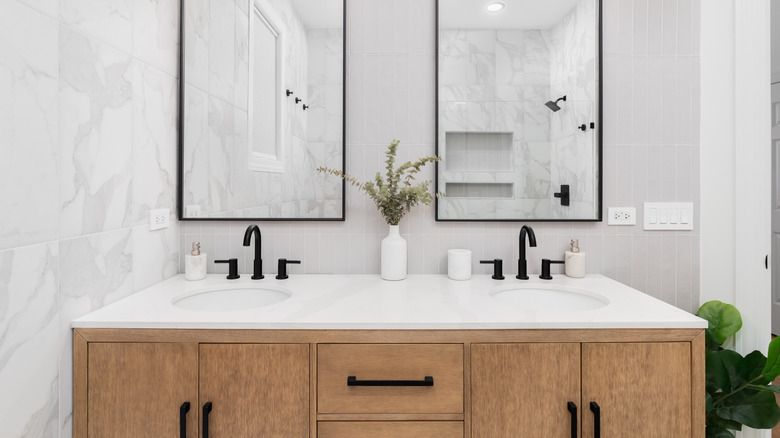What Is The Standard Height Of A Bathroom Vanity?
For decades, the standard height of a bathroom vanity was 30 to 32 inches, but this range may be less common today. People are generally taller now than our ancestors were, and the height of a 50-year-old bathroom vanity may be woefully short for a modern family. Happily, modern vanities come in a wide range of heights, so anyone can customize their bathroom to suit their personal preferences. Don't be too quick to install a vanity at any height without first weighing a few pros and cons.
Tip: The standard height of a bathroom vanity used to be 30 to 32 inches, but today it's common to see vanities that are 34 to 36 inches in height.
The Height of Comfort
When shopping for a new bathroom vanity, it's common to see the phrase "comfort height" used. Instead of a focus on what's traditional, retailers are all about customization. Determining what height feels right for you is the most important factor.
Not sure what height is most comfortable for you? Grab a tape measure and head for the kitchen. If the height of your kitchen counters makes it easy to chop veggies or mix batter, it's also likely a good height for your bathroom vanity. If you're bending forward or lifting your elbows like a bird readying for flight to accommodate the kitchen counter, a slightly higher or lower vanity may be in order.
Factor in every occupant's height and abilities, remembering that someone in a wheelchair has specific needs, and that children don't stay small. Also, consider that a tall vanity can result in less bending while brushing your teeth or washing your face, which may be useful for someone with back problems.
Considering Vanity Options
When planning for a new bathroom vanity, think beyond just the height of the countertop. There's a lot of variation in style and form that could affect how tall your final vanity is.
A raised basin or vessel sink calls for a lower vanity to bring its top edge or rim to a comfortable height. How far a particular sink's rim sits from the finished floor is what counts, so calculate the basin's installed height plus the vanity's height, if you aren't using an all-in-one unit. Conversely, an under-mount sink can mean even more bending since it sits lower than drop-in styles.
Floating or wall-mounted vanities offer airiness, but if they're positioned too low they merely provide somewhere for dust bunnies to burrow. Choose a design that leaves enough space underneath without being too high or low for your comfort. For someone in a wheelchair, install a floating vanity at an appropriate height for knee space and easy access.
Calculating Countertop Thickness
The countertop typically adds 1/2 to 2 inches of height to the vanity, depending on the material. Countertop thickness is also aesthetically important: A thick stone slab, for example, appears more substantial than a thin one, but can perceptively squash a sleek vanity or slender-legged cabinet.
If you have the skills, revive an old vanity by painting the countertop or by changing its height; add or remove risers or revamp the apron. As you mull over an appropriate vanity height, also consider how everything else relates to it, including mirror and toilet size. Just as the standard height of a bathroom vanity has inched up over the past decades, traditional toilet height has also grown from 17 to 19 inches, floor to seat.
